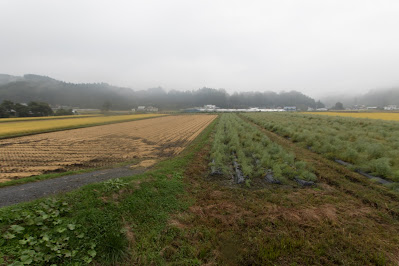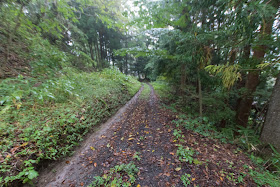Joboji Castle
-Similarity of medieval castles at north edge and south edge-
Overview
Name: Joboji castle (Joboji-jo)
Alias:
Place: Hachimandate Joboji-cho Ninohe city, Iwate
Type: HIll Castle
Built: 14th century?
Remaining remnants: Clay walls and dry moats
Title:
Brief History
Joboji castle (浄法寺城) is built over the edge of plateau which prolongs from Inaniwa-dake mountain eastward, toward the valley of Appi-gawa river. Appi-gawa river is a major tributary of Mabechi-gawa river which flows from north part of current Iwate prefecture toward its river mouth to Pacific Ocean at Hachinohe city of current Aomori prefecture.
The long valley of Appi-gawa river spreads north and south ward has been used an important road connecting Kitakami basin and Hachinohe plain, as even now used as a route of Hachinohe Jidoshado Expressway. Besides, just at the south of Joboji area, there is a gentle moutainous route across Ou mountains toward Kazuno area, a northeastern edge of current Akita prefecture. Because of this geographic condition, Joboji area has been an important place for local communication.
Origin of Joboji castle and Joboji clan
Precise year is unknown but Joboji castle might be built by local lord Joboji clan in 14th century. Joboji clan was said as a descendant of Shigetada Hatakeya (1164-1205), a major retainer of Yoritomo Minamoto (1147-1199), the founder of Kamakura Shogunate. Shigetaga was known for his braveness and culture, but after the death of Yoritomo, Shigetada was falsely accused for attempting revolt and was subjugated.
At the fall of Hatakeyama clan, one son of Shigetada escaped to Tohoku region and lived at Joboji area then became the local lord of the area. Same as surrounding local lords, Joboji clan placed their branch families around the territory and gradually expanded their area. However, as their territory was just at the next of Nanbu clan, a strong lord which once seized most part of north edge of Honshu main land, thus Joboji clan became the retainer of Nanbu clan from early period.
At the period of Harumasa Nanbu (1517-1587), Nanbu clan aggressively expanded their territory around current Aomori prefecture, northeastern part of Akita prefecture and northern half of Iwate prefecture. Nambe clan fiercely struggled at Kazuno area of Akita prefecture against Ando clan, and because of the closeness Joboji clan fought at battles as the vanguard, along with Kunohe clan which was a strong branch family of Nanbu clan and resided just at the north of Joboji clan.
Structure of Joboji castle
Joboji castle is built over a plateau of 30 meter height from hillside, which spreads about 500 meter long and 250 meter wide. At the east of castle site there is a flat ground of about 800 meter long and 400 meter wide which is wholly encircled by Appi-gawa river, castle hill and north side mountain, and it was a suitable place to build a castle and castle town.
Joboji castle roughly consist of six terraces which are same levels and separated by deep valley. Hachiman-date area which locates at the southeast edge might be the main area of the castle, which size is about 250 meter long and 100 meter wide. Now used as a farm, but small terraces surrounding main part still remain.
At the middle part of the castle, there are three areas named Odate-area, Nishidate-area and Shindate-area which shapes is like a rotating fan. These areas are well shaped but not so securely protected, thus there might be residences of branch families or important retainers of Joboji clan.
At the northwestern edge, there is a large Kita-date area which is about 300 meter long and 150 meter wide. Unlike other areas this area is not so well shaped, and might be used as a camping space of lower retainers or storage space. Total size of the castle is equal to the castles of important branch families of Nanbu clan such as Kunohe castle of Kunohe clan or Nejo castle of Hachinohe Nanbu clan, and this shows the power of Joboji clan in Nanbu family.
Similarity of castles in north and south edge
Nanbu clan and its retainers built many medieval castles of this kind of shape, which consist of several same level terraces just gathers and do not have clear order among these terraces. It includes Ishikawa castle, Nejo castle (Aomori prefecture), Kunohe castle and Joboji castle (Iwate prefecture), or Namioka castle (Aomori prefecture) of Namioka clan have same style.
Contrary to this, in the south half of Kyushu island, Shimazu clan or Ito clan also built this kind of castles called as “Gunkaku-gata” (terrace gathering shape), such as Izaku castle, Chiran castle (Kagoshima prefecture) or Tonokori castle (Miyazaki prefecture). There might be two reason which same shape castle were built at the north and south edge of Japan.
One reason is the matter of soil. There widely spread “Shirasu plateau” which was a thick layer of volcano ash all around the south half of Kyushu island. This soil tend to form a group of terraces deeply eroded by waters, and its sheer cliff makes it a natural castle just adding gates of the areas. Most part of medieval castle in the south half of Kyushu Island was built utilizing this ground.
Same as Kyushu island, there is a layer of volcano ash at the north edge of Honshu island exploded from Towada volcano. Now Towada volcano became Lake Towada-ko because of the collapse of the body, but once it explodes it is expected to bring severe damage to surrounding areas, which was the territory of Nanbu clan. Castles of Nanbu clan were also built utilizing the layer of volcano ashes.
Structure of clan affected shape of castle
Another reason was a structure of each clan. At first local lords of medieval area which achieved their territory at the establishment of Kamakura Shogunate inherited their lands dividing to branch families, and each clan became the assembly of same level branch families. Of course there was a main family but their power was not so strong and decision of the clan was made from consultation of families.
However, in the central area, such structure gradually collapsed and centralization of main family proceeded, because of the continuous battles and growth of the commerce. The winners gathered territories of loses and sometimes beat former main families, and merchants formed castle town around the castle. Order of the families in the clan became apparent, and it affected the shape of castles.
Contrary to this, at the north edge and south edge of Japan, local lords are less involved in the battle as it was far distant from central area and had no enemy at backsides. Commercial activities did not so grow at this time, and there was a vast land compared to the population at marginal area and it could still divide the territory. This condition brought gathering type castles at north and south edge of Japan.
Centralization of Nanbu clan and fall of Johoji clan
However, at the final decade of Sengoku era, Nanbu clan had to eliminate this decentralized structure. In 1590, at the Odawara campaign of central ruler Hideyoshi Toyotomi (1537-1598), Nanbu clan decided to subordinate to Toyotomi government. But antipathy for main family of Nanbu clan who was admitted as the lord from central government, Masazane Kunohe (1536-1591), a major branch family of Nanbu clan, raised his army against main family and central government.
Facing at the rise of Masazane Kunohe just at the north of the territory, Joboji clan belonged to main family of Nanbu clan and stood against Kunohe army. Later Masazane Kunohe was subjugated by overwhelming army of central government, and Nanbu clan established their monopoly at last. Joboji clan became one of the important retainers of Nanbu clan, but Joboji castle was abolished under the order from Government.
In 1600, at Hanamaki area where was the southern border of the territory of Nanbu domain, former lords such as Waga clan or Hienuki clan raised their army under the support of Masamune Date (1567-1636), the lord of Sendai domain. Nanbu army drove back of the attack of enemy reversely encircled Iwasaki castle, the main base of raised army but it became winter.
Looking at the cease of the battle, the leader of Joboji clan returned to his territory without approval, but later was accused of this leave and expelled. At this time Joboji area was an important to connect Sannohe area which was original territory of Nanbu clan, Morioka area where the center of Nanbu domain and Kazuno providence ahead of Oshu mountains, and Nanbu clan tried to manage this area by themselves.
Now all building was lost but shape of terraces surrounded by sheer cliffs is well kept. After the fall of Joboji clan, castle town kept its prosperity as a posting town of Joboji Kaido road, which was a bypass road of Oshu Kaido road and route to Kazuno area, and its regional product Japanese lacquered items. Old houses of Joboji town and Tendaiji temple, one of the oldest temples in Tohoku region, quietly tells past prosperity of Joboji clan and Joboji castle until now.
Access
Bus ride from JR East Tohoku Shinkansen line / IGR Iwate Galaxy Railway Nihohe station. 15 minutes drive from Hachinohe Jidoshado Expressway Joboji interchange.




























































































































No comments:
Post a Comment